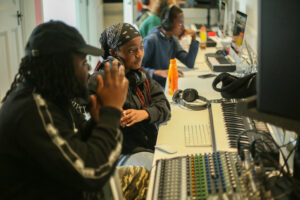
Beginner Read Digital Strategy
An effective digital strategy can be vital to your organisation’s success. Read on to understand the key considerations when developing yours.

Fellowship Music Collective 1, Photo © Clive Tagg, Lewisham Music, Southbank Centre 2019 – massed voices
Before joining the Digital Culture Network, my job as a content creator involved lots of product launches and corporate events that required video content to be captured and uploaded the very same day as the event. When it comes to social media marketing, showing off your latest and greatest event 3 months later on your social platforms will not bring you the results you are looking for. In this article, I am going to cover simple but crucial ways to create successful videos that are filmed quickly and efficiently, and edited and uploaded in record time. So, strap in and let us get started.
The list of shots does not have to be an elaborate list, it is more of a guide to what you are likely to need and what you can skip if time gets away from you. Always think about the objective for example:
Objective: to promote a museum’s live exhibitions. To do this, we will create a short 60 second video for Twitter, Instagram, Facebook, and YouTube
You get the picture. In our example, the video needs to highlight a museum’s attractions and live exhibitions, but the process can easily be adapted to cover a play or an event. With people consuming so much digital content these days it is difficult to stand out from the crowd. Therefore, in most cases, a traditional slower approach of establishing shots to set the scene may be less engaging for viewers scrolling through their social media feeds. You may want to consider a more dynamic, attention-grabbing shot.
What does a dynamic shot look like? In the case of a venue such as the Tank Museum having the camera coming out of the barrel of a gun to reveal the huge tank might be more captivating than a standard wide shot. Consider a time lapse of museum visitors enjoying a particular exhibit. If you are looking for a way to demonstrate the sheer size or success of an event using just 10 seconds of video, you could try walking around the venue with your camera on Time Lapse (sometimes called Hyper Lapse). Essentially, your device takes a photo every second or so, and stitches it together to create a video that can be either added to an existing video or uploaded on its own.
When filming for a gallery or a dance company, you could focus on having longer shots of the subject to give the viewer more time to absorb the visual art. Remember that you will still need to not only capture the attention of the viewer but retain that attention for as long as possible. Through consistent video production, you will begin to understand what your audience expects to see.
A pro tip is to film in slow motion, this allows you to have as much chance as possible to capture the footage you need. Switching your camera or phone from 30 frames a second to 50 or 60+ frames a second will give you double the footage, meaning a 4-second pan shot is now 8 seconds, which will give you more to work with in the edit.
Elaborating a little more on the use of slow motion, one of the best attributes of video is the ability to capture the most wonderful of moments. Happy, smiling people look even better being filmed in slow motion. Slow motion always amplifies the emotion in the most pleasant of images. So, if you have a winter wonderland with fake snow and happy, smiling faces, do not be shy about getting close to the action and showing your online audience what they are missing. You need to make sure you are close to the action. Filming at the back of the room is less embarrassing for you but, if you cannot see what is going on, how will someone watch it vertically on a 6-inch phone screen? You need to put on your cloak of invisibility and get in among the action.
As a freelancer, in most cases, I was not told in advance what I was going to film, so it was important to get an idea, from whoever was overseeing the running order of the event, whether there was anything that needed to be captured or something that should not be filmed. Having a schedule of an event will help but sometimes these are not forthcoming, so it is important to make your own list. Check each of the things off your shot list, and if you feel you are missing something, get another shot for luck. Obviously, it is impossible to ask someone to go back on stage and give an entire speech again for you, but in those situations, you need to be even more prepared. In a pinch, I have sometimes put my mobile phone close to the subject speaking and recorded the audio in a voice memo app. This ensures I have at least got something close to the impromptu speaker that can be used in the edit.
Soundbites / VOX pops. Basically, talking heads, people who are happy to go on camera and say what they love about the venue, event, or performance. These are fantastic for capturing an authentic voice of the audience, real people who have enjoyed the experience. You can even engage with the cast and crew from behind the scenes, and ask for a few words to help illustrate the wonderful perspective of the process of putting on a play, show, or event.

M6 Youth Theatre, Photo © Alan Hamer
Ideally, you will have copies of a release form ready at hand that explains where the footage will be used, and that the person agrees to their image and comments being used. If you do not have this to hand, then this is not a problem as you can also record them on camera saying they are happy for you to use their footage. Sometimes, for whatever reason, someone does not want to be on camera and may make this known to you, if this is the case make sure not to include them and respect their wishes. The one thing no-one can teach you is knowing when you have enough, when is it time to call it and start editing. This will come with experience.
Switching over to editing, you may have the feeling that you have extraordinarily little usable content, but it is now that creativity comes into play. You know you have those time lapses of the audience or crowd; you might have the odd talking head Vox pop with a key soundbite or two. Then there is the outside of the building to establish where we are, a sprinkling of slow motion happy, smiling faces, and before you know it, you have 60 seconds of great social media content. In most cases, I get inspired by something I have seen in the playback from the clips or rushes I have taken; that helps me choose my first shot.
I have been using Final Cut Pro X for over a decade, and it is by far the fastest non-linear editing platform I have experienced. A free PC alternative with similar attributes is Blackmagic’s Resolve which has some wonderful features but it is a little harder to get started. Many professionals are using Resolve, so getting to grips with it for your career progression might pay off, especially as it is free to use the basic version which has great features. Other options like Canva or Capcut are browser-based editors with more user-friendly interfaces to help you get to grips with the concept of editing on non-linear editing software. Both will enable you to upload footage, cut and put it together, add titles and music, then export it in whatever format you desire.
By the time you are at editing stage, you will have realised that either, A: you have shot too much footage and most of it is on the “editing room floor” or B: you have not shot enough. Do not worry either way this will inform you of what needs to be done next time and will help prepare your list on future projects.
You can either go back out and shoot a couple more moments of footage to help finish it or, if that is not an option, try changing the edit around. You can slow down a certain part of the video or use a clip that might be not perfect and make it into black & white monochrome section to establish an unexpected, yet flamboyant element to your video. Consider subscribing to the “less is more” philosophy and accept that this time this is all that can be done. Practice makes perfect. Your last video is not as good as your new one, and the next one will be so much better than the current one.
I use a few royalty-free music sites and I have listed them below. In most cases, I have already put in the arduous work and listened to the first 30 seconds of around 20 songs, which helps to inspire my editing choices. Everyone is different but you ideally do not want to be spending forever searching for the perfect track to use. Another great tip is to skip forward to a third of the way through the track and see if the middle of the song has what you are looking for. Sometimes songs take too long to get started, but three-thirds of the way through will show if it is the right track for you.
Watch it through several times, check for cuts on the beat. The beat of the track is shown in peaks on the music track’s audio file. If you align the visual content to the music, you will have a more flowing piece of content. This might not work for all songs, but it is worth paying close attention to and will make you a more efficient editor on the fly.
Create a shot list and include all the amazing things that need to be filmed (or you might get caught out).
Have all your permissions sorted before you publish. There is nothing worse than making content only to then take it down because you failed to get permission.
Edit with a platform you feel you’ve already mastered.
Have a few song choices lined up for when you edit. Find somewhere quiet where you can hear all the nuances of the music so you can make your edit more impactful.
Some videos have greater impact and resonate with audiences better than others. Keep an eye on your video analytics and performance to help you understand how long a viewer watches your video, at what point they click off, and if it receives likes and shares. Knowing this information should inform your editorial decision-making going forwards
And of course, practice and practice as much as you can. Nobody is born with the ability to perfectly make expert content without making some mistakes along the way. It does not matter what equipment you use; your knowledge and experience will always be more useful than a 4th lens on a mobile phone that can zoom into the surface of the moon.
The Digital Culture Network is here to support you or your organisation. Our Tech Champions can provide free 1-2-1 support to all creative and cultural individuals and organisations who are in receipt of, or eligible for, Arts Council England funding. If you need help or would like to chat with us about any of the advice we have covered above, please get in touch. Sign up to our newsletter below and follow us on Twitter @ace_dcn and LinkedIn for the latest updates.
Beginner Read Digital Strategy
An effective digital strategy can be vital to your organisation’s success. Read on to understand the key considerations when developing yours.
Beginner Read Email Marketing
Email marketing is a powerful tool when it comes to building relationships with your audience. Read on to find out more about what it can do for your organisation.
Beginner Read Video and Digital Content
Storytelling is the key to amazing content. Read on to understand how to incorporate great content into all facets of your digital marketing.
Beginner Read Video and Digital Content
Storytelling is the key to amazing content. Read on to understand how to incorporate great content into all facets of your digital marketing.
Beginner Read Video and Digital Content
Here are five things to bear in mind when making your next video.
Beginner Read Video and Digital Content
Looking for ways to make your content work harder for you? Our checklist will help you create more engaging material for your target audience.



